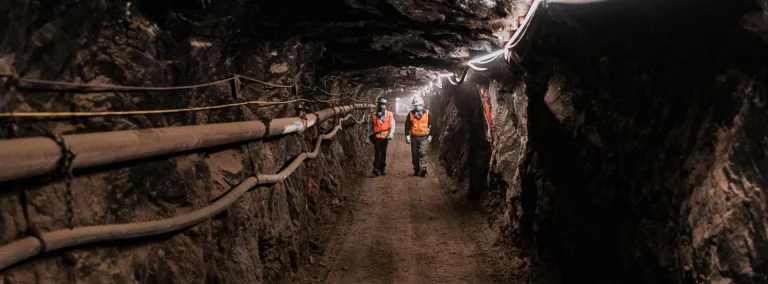Teams rigorously inspect facility levels
With hundreds of miles of tunnels and drifts, SURF ensures safe working conditions through Annual Level Inspections
The Sanford Underground Research Facility (SURF) is a matrix of interconnected shafts, drifts and ramps. With hundreds of miles of underground space, SURF maintains over 12 miles for science activities. Some of these areas boast concrete flooring, flush toilets, WIFI and even an espresso machine. Other spaces, however, are less maintained. While they are not used for science, adverse conditions in these areas could affect science and operations efforts elsewhere in the facility.
To ensure safe conditions, the Underground Operations Department inspects every level of the facility from bottom to the top. These Annual Level Inspections assess each level’s ground support conditions, structural integrity, water inflow, ventilation and other environmental issues. Inspections are done more frequently for escapeways and essential ventilation and water inflow controls.
“We have predefined points identified for each level, including legacy shafts, timber lines and any other structures that could fail at some point,” said Jason Connot, underground operations engineer at SURF. “At each point, we evaluate conditions and document changes, making sure conditions are consistent from year to year.”
Level inspections ensure the infrastructure of the underground doesn't adversely affect SURF’s mission or the experiments hosted underground. The inspections also fulfill requirements outlined in the property donation agreement formed when Barrick Gold Corporation donated the facility to the South Dakota Science and Technology Authority.
For 120 years, the Homestake Mining Company excavated more than 370 miles of shafts, drifts and ramps. The facility’s oldest, shallowest levels were created in the late 1800s. When the facility reopened for science, Tom Regan was among the first to begin inspecting levels for safety.
“In 2008, we reentered the underground, going top-down, level by level,” said Regan, a former employee of Homestake and SURF, now a safety consultant for SURF. “We created a checklist of items to inspect, to see what condition the facility was in. Those inspections created a baseline library for annual level inspections.”
As Regan’s crews gained more access to the underground, they installed ground support where needed and eliminated hazards throughout the facility. Crews also installed more than 50 timber water walls, supported by steel posts and angles, to prevent water inflow from accessing the Yates or Ross Shafts.
Today, the department focuses on maintaining level conditions and cataloging information. George Vandine, underground infrastructure coordinator at SURF, manages the current dataset, which captures three years of detailed information on every level of the facility.
“Saying that a legacy pipe fell down on the 4550 Level doesn’t give us enough information to repair the area,” Vandine said. “Our management system includes detailed maps, notes and photos to help teams pinpoint any issue, anywhere underground.”
After a level inspection, Vandine inputs information into the management system. From there, the Underground Operations Department prioritizes and executes repairs and mitigation projects as needed.
“When doing these annual level inspections, the key to success is really knowing the levels—understanding how levels interact with other levels, understanding airflow and water flow between levels,” Connot said, noting that he has gained valuable knowledge by working with Regan, Vandine and others. “I try to soak in that knowledge from these experienced guys so we can continue to build on their expertise.”
